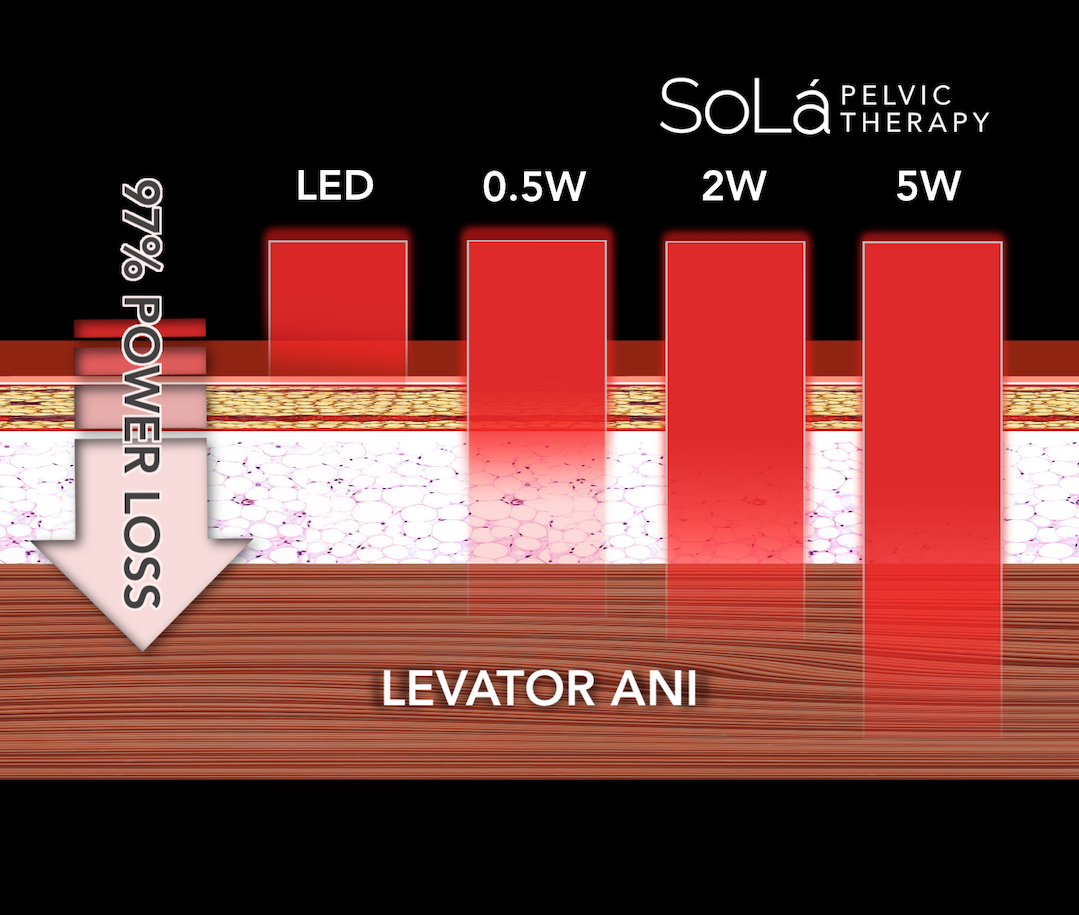We Strive to be Champions of Both Treatment and Data Collection.
The SoLá Pelvic Therapy patient touch screen captures the responses of every patient at every treatment in every clinic. This allows you to observe changes to pain symptoms as they occur. This also allows for the secondary analyis of a nation-wide limited data set.*
*A limited data set is a data set that excludes personally identifiable information. Our analyses have been published in multiple peer-reviewed journals.
Most patients describe the treatment to be soothing.
Healthcare Providers and Administrators may use this button to set up a Zoom call.
The SoLá Pelvic Therapy Mechanism of Action
The Class IV near-infrared laser SoLá Pelvic Therapy Laser is protected by multiple device and method patent claims. The predominant mechanism of action is photobiomodulation. Photobiomodulation (PBM), previously referred to as Low-Level Laser Therapy (LLLT), is a form of near-infrared (NIR) light therapy shown in systematic reviews to improve pain in musculoskeletal conditions.[1-3]
This is a video that shows how that demonstrates the SoLá Pelvic Therapy procedure and mechanism of action. The video includes audio narration.
PBM uses non-ionizing light energy, in a non-thermal process, to affect the mitochondrial chromophore cytochrome c oxidase (COX).[4] The NIR light triggers biochemical changes initiating a chain of intracellular chemical reactions.[5] Nitric oxide (NO) is displaced from the mitochondria. NO is a mitochondrial waste product that is capable of binding to COX and displacing oxygen, especially in injured or hypoxic cells.[6] NO is a powerful relaxer of both smooth and skeletal muscle, and it is also capable of reducing muscle pain and improving circulation to oxygen-deprived tissues.[5,7,8] Additional benefits are believed to be secondary to activation of various transcription factors that result from mitochondrial stimulation as well as the modulation of reactive oxygen species.[9] Unlike typical lasers that emit energy in cylindrical beams, the SoLá Pelvic Therapy Laser uses a proprietary fiber and spherical probe to emit energy as a diffuse orb. The gentle in and out motion of the 2 cm spherical wand is designed to encourage the egress of inflammatory extracellular fluids through lymphatic channels.
Patent Protected and Automated Patient-Specific Dosing
Although millions of photobiomodulation treatments have been performed over the last decade, none had been performed inside the pelvis. We performed extensive research on the bench-top, in the animal lab, and across clinical trials to determine optimal dosing. Our real-world data collection user interface has allowed us to further refine and patent protect this dosing.
The SoLá Pelvic Therapy Laser utilizes vaginal length and radius to query our dosing tables and set patient-specific dosing (power x time). Typical treatment times are two to four minutes.
Reproducible, Simple, and Quick!
We designed our system and method to be highly reproducible. The near-infrared energy is transmitted in a 360-degree orb. Hence, there is no aiming. This allows physician extenders who may be less familiar with pelvic anatomy to easily perform the therapy. The gentle in and out movement of the probe is standardized by an auditory metronome calibrated by vaginal length.
Dosing is automatically set by the laser. Calculations are made utilizing wand-measured vaginal length and radius. The mean time to maximal improvement is 4-6 treatments. The recommended therapy regimen is 8-9 treatments over 3-4 weeks. Remember, each treatment takes only a few minutes.
Can you treat pelvic pain with an LED device or a milliwatt laser?
We performed extensive bench and in vivo testing. We implanted near-infrared sensors into the levator ani and throughout the pelvis. We learned that there is 97% power loss between the vaginal mucosa and the levator ani. A minimum of 2W was required to deliver therapeutic dosing to the levator ani and bladder. Additionally, when energy was transmitted as a conventional beam rather than as a spherical orb, hours were required to effectively dose the pelvic muscles. SoLá Pelvic Therapy treatments are typically provided at 4-7 Watts in an orb array.
Did you know?
Did you know that up to 85% of patients with chronic pelvic pain (including your endo and IC patients) may suffer from pain related to their pelvic floor hypertonicity (levator myalgia)?[10,11] SoLá Pelvic Therapy utilizes photobiomodulation, a painless, non-dustructive modality capable of reducing muscle hypertonicity.
Photobiomodulation Lasers are Nondestructive
You may be familiar with destructive (“ablative”) CO2 and Yag lasers that have been used off-label to to treatment of vaginal atrophy and vaginal symptoms of menopause. Those lasers transmit wavelengths of energy that are strongly absorbed by water. Their mechanism of action, ablation, relies heavily on destruction of tissue with subsequent inflammation, proliferation, and remodeling. SoLá Pelvic Therapy utilizes near-infrared wavelengths which are minimally absorbed by water. The mechanism of action, photobiomodulation, is non-ablative (non-destructive). See Mechanism of Action section above. Additionally, the SoLá Pelvic Therapy Laser transmits NIR energy as a spherical “orb”, rather than the traditional beam.
Patient Selection
Approximately 14% of women (and 9% of men) suffer from chronic pelvic pain.[12,13] Although these patients may be given diagnoses ranging from endometriosis, interstitial cystitis, bladder pain syndrome, pelvic congestion syndrome, pudendal neuralgia, and symptomatic diagnoses such as dyspareunia, vulvodynia, and vaginismus, they have something in common. Up to 85% of these patients have hypertonic, tender, pelvic muscles.[10]
SoLá Pelvic Therapy has been developed to address hypertonic pelvic muscles found in up to 85% of patients whose CPP. The hypertonic pelvic floor is identified by a single finger pelvic examination of the pelvic musculature.






